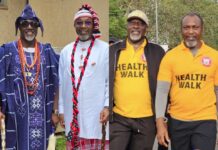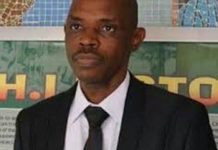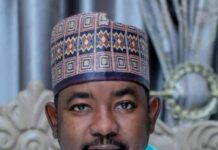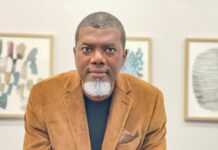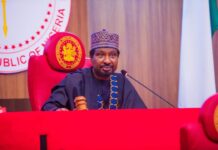Dissuading debates, persuading pragmatism on Almajirci Reform, by Khalifa Dankadai
POLITICS DIGEST- By now, some concerned citizens, especially in Northern Nigeria, have started losing hope in Tsangaya (Almajirci) school system reform. While some onlookers recommend a total ban of the system, other active citizens like me are focused on practicable solutions by working with Executive and Legislative arms of Government at Federal, States, & Local levels, other relevant stakeholders, and local leaders in Tsangaya communities to develop and pilot high impact and sustainable models for comprehensive, community-driven, and lasting Tsangaya Education reforms toward a standardized, integrated, and strictly skill-based learning system.
My team and I are currently working in Kano, Jigawa, Katsina, Zamfara, Sokoto, and Niger States to reform 60 Tsangaya schools and train 6000 Almajiri students by next year through working with Alarammas to pilot our skill-based Tsangaya school curriculum and administer our newly developed Tsangaya schools operational guidelines; both of which were developed together with Alrammas, Government officials, and other relevant stakeholders; based on our research, expertise, and accumulated experience in implementing Tsangaya reform initiatives for almost a decade now.
The reason why I wrote this article is to dissuade online social media disputants from debating whether Tsangaya Education is good or bad and invite them to review our robust Tsangaya Education reform model which I know will rekindle the hope of many and restore their confidence in witnessing a reformed Tsangaya Education system in the near future. Let us analyse some of the challenges vis-à-vis our proffered solutions to them.
Firstly, let us start by acknowledging that the inadequate or complete LACK OF REGULATION of the Tsangaya Education system place the Almajiri students in Tsangaya schools at a HIGH RISK OF abuse, exploitation, radicalization by violent extremists, and recruitment into gangs. The socioeconomic and mental conditions of the Almajiri pupil makes him VULNERABLE AND NEGATIVELY EXPOSED TO violence, crime, drugs, etc.
Therefore, we are working with Government and relevant stakeholders to REGULATE the Almajirci system by standardizing it into an integrated and strictly skill-based learning system through administering an integrated curriculum and operational guidelines for standardization of Tsangaya Schools and working with Stakeholders and Local Leaders in rural communities to address rural to urban and interstate Almajiri child migration through creating integrated learning, skills development, and economic opportunities in rural communities to serve as positive alternatives to out of school children and at risk youth in a bid to curb undesirable flow of Almajiris in the northern region toward achieving a successful and sustained Almajirci reform, thereby sustainably deradicalizing disgruntled rural youths that are at risk of joining violent extremist groups and gangs of armed bandits.
Secondly, most of the attempts to reform and regulate the Almajirci system of education are usually THROUGH INTERVENTIONS and NOT ACTUAL REFORMS that are designed to be organic (bottom-top) and become standard practice. Most of the interventions in this space are engaging, beneficial, and charitable; but their impacts are usually limited to the particular project’s performance period and specific locations where they are implemented without necessarily making provisions in the project design for real sustainability and scalability of the impact to spread organically to other locations. For instance, an intervention project may sponsor mainstream education teachers to selected tsangaya schools, provide books, uniforms, and meals for the Almajiri students, some even provide allowances for the Alarammas to engender acceptability; just for the project’s performance period usually without specific project components and methods for sustainability and without an explicit intent of using this phase as a milestone for learning toward expansion to achieve a reform through interventions. Also, this approach usually ends up with some of the Alarammas taking the schools back to their old ways after the intervention project performance period after they (some of the Alarammas) have benefitted from the material gains in the project, especially since most of the intervention projects are not designed with the Alaramma’s inputs.
Therefore, WE TAKE THE REFORM FOR CHANGING BEST PRACTICE APPROACH that works closely with the Tsangaya communities for real sustainability and scalability of the impact to spread organically to other locations.
Read Also:
Thirdly, most of the interventions that aim for reform usually make the same MISTAKE OF ADOPTING THE TOP-DOWN APPROACH to the reform where project leaders design and implement their project from the top without adequate grassroot consultations and community inclusion instead of the organic community-driven bottom-top approach that works with the communities to nurture community inclusion and community ownership for natural sustainability. Because of the nature and peculiarities of the Tsangaya communities, community inclusion goes beyond just going to the Alarammas for data collection or a one-time focus group discussion. The bottom-top approach outlines and agree with the Alarammas on specific project outcomes, then work with Alarammas and other relevant stakeholders on design and methodology for seamless implementation. The bottom-top approach works with the communities thereby giving them more capacity to solve their problems on their own, it also turns the communities into ambassadors and advocates of the reform because they take ownership of the reform and they protect it, because it was developed and achieved together with them based on their own inputs, hence the highest likelihood for impact sustainability and spread.
Therefore, WE TAKE THE BOTTOM-TOP APPROACH.
Fourthly, the top-down approach usually leads some of the initiatives to VIEW AND TREAT TSANGAYA SCHOOLS AS FORMAL SCHOOLS or like the islamiyya and tahfiz schools as opposed to the non-formal community schools that they are. This is where most of the efforts by both state and non-state actors on Tsangaya curriculum development fail. Some of the Tsangaya curricular include up to 10 formal schools core subjects. But the questions are, who will sustainably teach these 10 subjects in traditional Tsangaya schools? Who will sustainably provide the instructional materials? (including computers because the some of the curricular includes computer studies). Where is the time to teach all these 10 subjects in a traditional Tsangaya school? (because based on Traditional Tsangaya Schools timetable, the Almajiri students only have Thursdays and Fridays off). Where are the guidelines to guide the Tsangaya schools’ operations for seamless implementation of the curriculum?
That is why we adopt the organic community-driven bottom-top approach that works with the communities and relevant stakeholders to develop a standard (one that is applicable across northern Nigeria and the lake chad countries), integrated (that comprise of essential components of mainstream education), and strictly skill-based (one that includes both life and vocational skills) curriculum and operational guidelines that conform to the values and socio-economic realities of the Tsangaya communities.
Lastly, LACK OF SYNERGY AMONG STAKEHOLDERS has been responsible for the fragmented and low impact efforts we have been witnessing toward Almajirci reform.
That is why we deliberately designed our projects to NURTURE SYNERGY AMONG STAKEHOLDERS AT ALL LEVELS. All institutions and organizations can have their interventions and reform programs, but we believe if there is synergy, we would have one direction toward a wholistic, coordinated, and regional Almajirci reform, thereby avoiding duplication of efforts, waste of resources, and confusion.
Most Almajiris in Tsangaya schools remain vulnerable despite the growing attention that the Almajirci system reform is currently witnessing. Failure to adopt a standard curriculum and administer operational guidelines for Tsangaya schools that include standardization of (1) building structure & facilities, (2) faculty & curriculum development, (3) teaching & learning methods, (4) administration & operations, (5) school fees & financial management, and (6) integration of essential components of mainstream education and vocational skills development programs in Tsangaya schools; consistently undermines the efforts of state and non-state actors toward a comprehensive and sustainable Almajirci reform. Similarly, inability to consciously address rural-urban, interstate, and cross border Almajiri migration will always mar the seeming success of any reform model that only focus on the Tsangaya schools in our cities.
By adopting a new curriculum and operational guidelines for Tsangaya schools, we will immediately begin to transform our Tsangaya schools into community-based citadels of integrated learning and skills development for human capacity and character building. Our population will become a blessing as we begin to reorient it and make it more productive. Also, for any Almajirci reform model to be successful and sustainable, it must be a regional approach that can be adopted by all northern states because of infiltration through interstate Almajiri migration.
Khalifa is a skill-based learning specialist and community development practitioner with keen interest in and passion for Tsangaya Education Reform.






